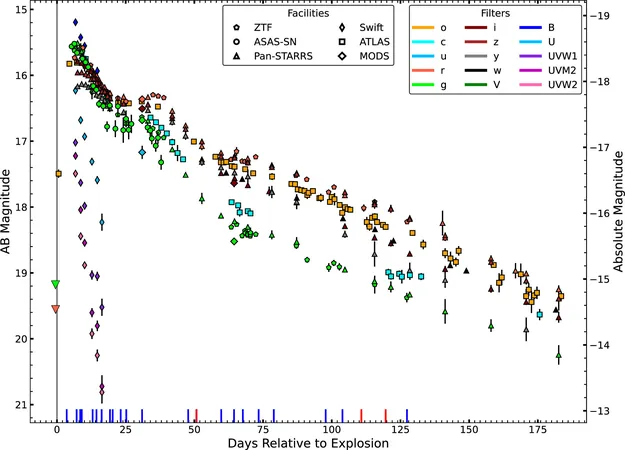
Astronomers Discover Rare Supernova, Unlocking Secrets of the Cosmic Dawn!
2024-11-25
Author: Ming
Introduction
In an exciting breakthrough, an international team of astronomers has observed an extraordinary supernova, designated 2023ufx, marking what could be the most metal-poor stellar explosion ever detected. This remarkable explosion emanated from a red supergiant star that met its end in a nearby dwarf galaxy, revealing crucial insights into the early universe's composition.
The Significance of Supernova 2023ufx
What sets supernova 2023ufx apart is its low metallicity—essentially, it lacks the heavier elements that typically form from stellar explosions. This finding is not just a scientific curiosity; it offers a glimpse into the universe's formative years when metals were scarce. According to Michael Tucker, the lead author of the study from Ohio State University's Center for Cosmology and AstroParticle Physics, "Understanding how the early generations of stars influenced their environments provides vital information about how galaxies like the Milky Way came to be."
Insights from Dwarf Galaxies
Dwarf galaxies serve as local analogs for conditions thought to have existed in the infant universe. Through studying these galaxies, researchers have determined that while the universe's first structures were metal-poor, the larger and more luminous galaxies surrounding the Milky Way evolved over time, increasing their metal content significantly due to subsequent star explosions.
The Brightness of 2023ufx
Interestingly, the properties of a supernova are shaped by its metallic content. For instance, a lower concentration of metals can result in fewer nuclear reactions and a shorter duration of brightness. In the case of 2023ufx, its brightness persisted steadily for about 20 days, a stark contrast to metal-rich supernovae, which typically shine for around 100 days. This unusual behavior raises questions about the supernova's rapid spin; researchers noted a substantial amount of fast-moving debris ejected during the explosion, suggesting that the progenitor star must have been rapidly spinning at the time of its catastrophic end.
The Role of Advanced Telescopes
The discovery of the 2023ufx supernova, made easier by the powerful capabilities of NASA's James Webb Space Telescope, was somewhat serendipitous. Metal-poor supernovae are generally faint and challenging to detect; however, the enhanced observational tools provided an unprecedented opportunity to analyze this star's unique characteristics.
Broader Implications of the Study
The implications of this study extend far beyond a single explosion. Observations like these provide deeper insights into the life cycles of metal-poor stars and how they interact with their cosmic environments. As Tucker elaborates, "If we aim to predict how galaxies evolve, understanding the influence of early exploding stars is essential."
Future Research Directions
Future research may focus on determining whether this supernova was once a supermassive star or whether it lost its materials to an undiscovered binary companion, enhancing our understanding of stellar evolution in the universe's earliest epochs. With each new discovery, astronomers edge closer to painting a comprehensive picture of our universe's origins.
Conclusion
The findings from this study, published in The Astrophysical Journal, not only reshape the narrative of stellar evolution but also kindle curiosity about the universe's mysterious beginnings. Who knows what other cosmic secrets await discovery? Stay tuned as we uncover more about the fascinating complexities of our universe!


 Brasil (PT)
Brasil (PT)
 Canada (EN)
Canada (EN)
 Chile (ES)
Chile (ES)
 España (ES)
España (ES)
 France (FR)
France (FR)
 Hong Kong (EN)
Hong Kong (EN)
 Italia (IT)
Italia (IT)
 日本 (JA)
日本 (JA)
 Magyarország (HU)
Magyarország (HU)
 Norge (NO)
Norge (NO)
 Polska (PL)
Polska (PL)
 Schweiz (DE)
Schweiz (DE)
 Singapore (EN)
Singapore (EN)
 Sverige (SV)
Sverige (SV)
 Suomi (FI)
Suomi (FI)
 Türkiye (TR)
Türkiye (TR)